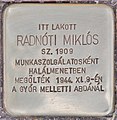Miklós Radnóti
Miklós Radnóti | |
|---|---|
 Miklós Radnóti | |
| Born | Miklós Glatter 5 May 1909 Budapest, Austria-Hungary |
| Died | November 1944 (aged 35) near Abda, Hungary |
| Occupation | Poet |
| Nationality | Hungarian |
Miklós Radnóti (born Miklós Glatter, surname variants: Radnói, Radnóczi; 5 May 1909 – 4 or 9 November 1944) was a Hungarian poet, an outstanding representative of modern Hungarian lyric poetry as well as a certified secondary school teacher of Hungarian and French. He is characterised by his striving for pure genre and his revival of traditional, tried and tested genres.
Biography
Miklós Glatter descended from a long line of Hungarian Jewish village merchants, peddlers, and pub keepers in Radnót, in what is now Slovakia.[1]
At the time of his birth, Miklós Glatter's father, Jakab Glatter, worked as a travelling salesman for the Brück & Grosz textile company, which was owned by his brother in law.[2] He was born in the 13th district (Újlipótváros quarter) of Budapest, the capital city of the Kingdom of Hungary. At birth, his twin brother was born dead and his mother, Ilona Grosz, died soon after childbirth. His father remarried in 1911 with Ilona Molnár (1885–1944). In 1921 his father died of stroke, his guardian became his aunt's husband, Dezső Grosz, who was one of the owners of the textile company his father worked for until his death.
Radnóti attended
In 1934, he finished his studies with the philosophical
In September 1940, he was conscripted to a
On 17 September 1944, the battalion was commanded to leave the camp on foot in two groups in a forced march to flee the advancing
Murder and its aftermath
In November 1944, because of their total physical and mental exhaustion, Radnóti and twenty other prisoners were fatally shot and buried in a mass grave near the dam at Abda, by a guard squad of a commander and four soldiers of the Royal Hungarian Army. Different dates of this mass murder have been given. Some publications specify a day in the period from 6 to 10 November. In the detailed and scientific exhibition of 2009 by the Hungarian Academy of Sciences, 4 November was claimed to be the date of death.[3][4][5][6][7][8][9][10]
On 19 June 1946, the mass grave in Abda was exhumed, and personal documents, letters and photographs were found. On 25 June 1946, Radnóti was reburied in the Jewish cemetery of Győr, together with twenty-one other victims.
On 12 August 1946, his widow, Fanni Gyarmati went to Győr with Gyula Ortutay, Gábor Tolnai and Dezső Baróti to identify the body of her husband that was exhumed for the second time. In his work titled Ecce homo (Canadian Hungarian Newspaper, 2011), Tamás Szemenyei-Kiss describes how at the time of the second exhumation in Győr, Fanni Gyarmati had not seen her husband and was shown several objects that had never belonged to Radnóti. Therefore, at the time of the third burial, she was no longer sure that the closed coffin really contained her husband's remains. Miklós Radnóti's third funeral service in Budapest was held in public on 14 August 1946. The
The commander of the guards involved in the mass murder, Sgt. András Tálas, immediately joined the
Bibliography (selection)
- Pogány köszöntő (Pagan Greeting), Kortárs, Budapest 1930.
- Újmódi pásztorok éneke (Songs of Modern Shepherds), Fiatal Magyarország, Budapest 1931.
- Lábadozó szél (Convalescent Wind), Fiatalok Művészeti Kollégiumának kiadása, Szeged 1933.
- Újhold (New Moon), Fiatalok Művészeti Kollégiumának kiadása, Szeged 1935.
- Járkálj csak, halálraítélt! (Just Walk Around, Condemned!), Nyugat Kiadása, Budapest 1936.
- Meredek út (Steep Road), Cserépfalvi, Budapest 1938.
- Naptár (Calendar), Hungária, Budapest 1942.
- Orpheus nyomában : műfordítások kétezer év költőiből (In the Footsteps of Orpheus: Translations of Poetry of Two Thousand Year Old Poets), Pharos, Budapest 1943.
- Tajtékos ég (Foamy Sky), Révai, Budapest 1946.
- Radnóti Miklós művei (Works of Miklós Radnóti), Szépirodalmi Könyvkiadó, Budapest 1978, ]
- Miklós Radnóti, The Complete Poetry in Hungarian and English, McFarland & Company, ISBN 978-0-78646953-6[12]
Miklós Radnóti was Hungarian translator of works by Jean de La Fontaine and Guillaume Apollinaire. His works were translated into English by Edward G. Emery and Frederick Turner, into Serbo-Croatian by Danilo Kiš, into German by Franz Fühmann and into French by Jean-Luc Moreau.[13]
Reviews
- Findlay, Bill (1980), review of Forced March, in ISSN 0264-0856
Image Gallery
-
Statue in Budapest by Imre Varga
-
Statue in Mohács by Imre Varga
-
Bust in Mosonmagyaróvár
-
Bust on Margaret Island
-
Miklós Radnóti—ELTE School in Budapest—Zugló
-
Stolperstein in Budapest
-
Memorial plaque
Articles
- History of the Jews in Hungary
- Hungary during World War II
- The Holocaust
References
- University of IndianaPress. Page 2.
- University of IndianaPress. Page 1.
- ^ Online catalogue of the Exhibition, Hungarian Academy of Sciences; retrieved 17 January 2018.
- ISBN 0-253-33801-8.
- , retrieved on 2018-01-17.
- ^ Death Blows Overhead: The Last Transports from Hungary, November 1944, European Holocaust Research Infrastructure (EHRI); retrieved 17 January 2018.
- ^ Article on Miklos Radnóti on the Website by the Poetry Foundation; retrieved 17 January 2018.
- ^ Final Poem,Translation 1 on the Website The HyperTexts,Translation 2 on the Website by Hungarian Academy of Sciences; retrieved 17 January 2018.
- ^ Grave Archived 1 May 2019 at the Wayback Machine of the spouses; retrieved 17 January 2018.
- ^ The fate of the Radnóti statue in Abda, report on the Website Hungarian Spectrum, retrieved on 2018-01-19.
- ^ Tamás Csapody: Abdai gyilkosok (The Abda Killers) in: Aetas 25:1 (2010)
- ^ Online edition on Google Books.
- ^ WorldCat by OCLC, retrieved on 2018-01-18.
External links
- One of his poems recited by Judi Dench (I cannot know)







